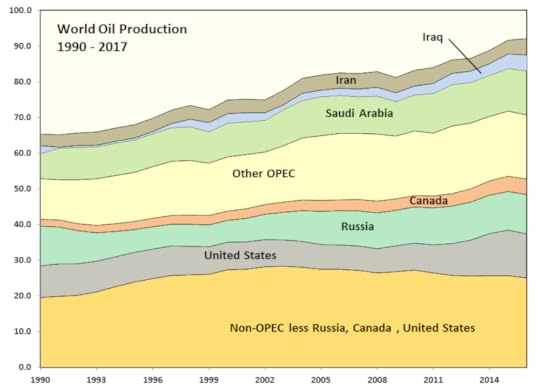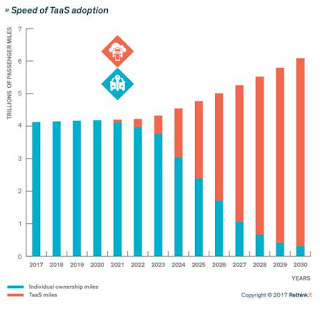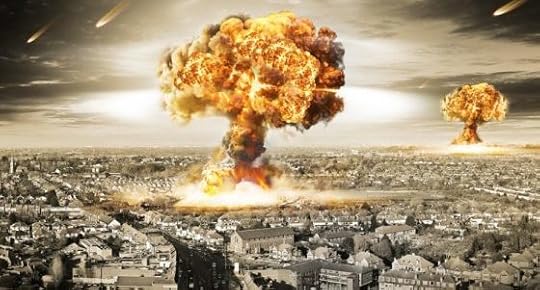Steve Bull's Blog, page 1225
December 21, 2017
‘Russiagate’ Is Actually Israelgate — Trump as Agent of Israel, Not of Russia
The Special Counsel Robert Mueller’s main evidence thus far in his “Russiagate” probe is not actually about possible Russian collusion with Trump to win the Presidency, but instead about definite Israeli collusion with Trump after Trump had already won the Presidency but before he became inaugurated. As a lawyer explained on the day when Trump’s former National Security Advisor Michael Flynn was indicted in a plea-deal: “Mr. Flynn has just become the prosecution’s star witness.” What Flynn had pled to was his trying to obtain Russia’s support for Israel’s Government, against the Palestinians. Russia said no; Putin said no to Flynn’s request, which had been made on behalf of Israel.
The way that Mueller’s investigation, to find reasons for Trump’s impeachment, achieved on December 1st the indictment and plea-deal with Flynn, was to get Flynn to admit (after his first having lied to deny) that he had been asked by Trump’s son-in-law Jared Kushner, who had been asked by Israel’s head-of-state Benjamin Netanyahu, to communicate to Russia’s head-of-state Vladimir Putin through Russia’s U.S. Ambassador, a request on behalf of the incoming U.S. Administration of Donald Trump, for Russia to get Israel out of a jam at the U.N. Security Council. Netanyahu didn’t want to be alone in trying to pressure Putin to turn against the Palestinians; he wanted the incoming Trump Administration also to be pressuring Putin to do that — for Russia to veto, this time, a resolution (#2334 in 2016), which, every year in the past, had been supported by Russia; or, failing to achieve that, to get Russia’s support for Israel’s effort to delay the Security Council’s vote, until after Trump would become installed as the U.S. President on January 20th. That’s what Putin was saying no to.
…click on the above link to read the rest of the article…
An Introduction to Political Economy
Last month, when I looked across the vast gray wasteland of the calendar page ahead and noted that there were five Wednesdays in November, I asked readers—in keeping with a newly minted but entertaining tradition here on Ecosophia—to suggest a theme for the fifth Wednesday post. This blog being the eccentric phenomenon that it is, it probably shouldn’t have surprised me that the result was a neck-and-neck contest between a post on nature spirits and a post on alternatives to capitalism and socialism, with a focus on democratic syndicalism. Nature spirits won by a nose, but there was enough interest in the other option that I decided to go ahead and write a post on that as well.
Nature spirits and democratic syndicalism may not seem to have much in common, but I’ve discovered one unexpected similarity: it’s very difficult to discuss either one in a single post. To make any kind of sense out of the ancient belief that the forces of nature are best understood and most truly experienced as persons rather than things, it turned out to be necessary to delve into the entire tangled mess our culture has made about the concept of personhood, and what does and doesn’t count as a person. Only when that was cleared away could we go on and talk about what it means to experience nature as composed of persons rather than things.
In the same way, if we’re going to make any kind of sense of the alternatives to capitalism and socialism, it’s going to be necessary to talk for a while about capitalism, socialism, and the third and usually unmentionable system of modern industrial economics—yes, that would be fascism.
…click on the above link to read the rest of the article…
Oil Price Outlook December 2017
This assessment is based on the data in the 2017 BP Statistical Review of World Energy available here. As such it uses that review’s definition of oil which is crude and condensate and natural gas liquids, uncompensated for their different energy contents or values of refined product components.

Figure 1: World Oil Production 1990 – 2017
This analysis was prompted by a chart by Ovi showing that Non-OPEC production less Russia, Canada and the United States has been in decline since 2004. That decline rate is 0.25 million barrels/day/annum. It had previously risen strongly from 1990.

Figure 2: Production Rate Change 2007 – 2016
The United States LTO patch is widely credited with having caused the oil price collapse of 2014. American production had risen by six million barrels per day since 2007. The United States was not alone with four other countries totalling six million barrels per day of production increase. Iraq and Saudi Arabia contributed two million barrels per day each with Russia and Canada contributing one million barrels per day each.

Figure 3: World Oil Consumption 1990 – 2016
OECD consumption has been flat even as OECD countries have had an increase in GDP.

Figure 4: Where the Oil Went
The fall of non-OECD consumption from 1990 to 1996 was due to the dissolution of the Soviet Union. Since then consumption growth has been steady at about 835,000 barrels/day/annum. Chinese consumption growth was 240,000 barrels/day/annum up to 2002 and then steepened to 512,000 barrels/day/annum since. OECD consumption growth was strong up to 2007 and then demand contracted due to higher oil prices. From here it looks like OECD consumption has plateaued. China may have also plateaued. Non-OECD consumption is likely to continue rising with a large part of that being due to India.

Figure 5: World Oil Production from 1990 with a Projection to 2025
…click on the above link to read the rest of the article…
The Golden Rule of Technological Progress: Innovation Doesn’t Solve Problems, It Creates Them

See that thing up there? It is an autonomous security robot, something that’s becoming fashionable nowadays. Obviously, for every problem, there has to be a technological solution. So, what could go wrong with the idea that the problem of homeless people can be solved by means of security robots?
There is something badly wrong with the way we approach what we call “problems” and our naive faith in technology becomes more and more pathetic. And now we are deploying security robots all over the world. Surely a “solution” but it is not so clear what the problem is.
The story of this silly robot made me think of a post that I published a few months ago where I stated what I called “the golden rule of technological innovation: “innovation doesn’t solve problems, it creates them”. And the more I think about that, the more I think it is true.
From “Cassandra’s Legacy”, May 24, 2017
The Coming Seneca Cliff of the Automotive Industry: the Converging Effect of Disruptive Technologies and Social Factors

This graph shows the projected demise of individual car ownership in the US, according to “RethinkX”. That will lead to the demise of the automotive industry as we know it since a much smaller number of cars will be needed. If this is not a Seneca collapse, what is?
Decades of work in research and development taught me this:
Innovation does not solve problems, it creates them.
Which I could call “the Golden Rule of Technological Innovation.” There are so many cases of this law at work that it is hard for me to decide where I should start from. Just think of nuclear energy; do you understand what I mean?
…click on the above link to read the rest of the article…
The Many SHTF Uses for Alcohol
 ReadyNutrition Readers, this article is not to expound on alcohol’s qualities as a beverage, but on the different type of alcohol and the uses it has. This valuable commodity has several uses from a survival perspective that are worth examining. In this piece, we will be examining the three most common types available to you. Let’s jump right into it and give you something you can use!
ReadyNutrition Readers, this article is not to expound on alcohol’s qualities as a beverage, but on the different type of alcohol and the uses it has. This valuable commodity has several uses from a survival perspective that are worth examining. In this piece, we will be examining the three most common types available to you. Let’s jump right into it and give you something you can use!
Ethanol (C2H5OH) is the common form of alcohol that you consume as a beverage/within a beverage. There are different percentages of alcohol per different beverages. Here are some rough “guidelines” of the percentages:
Vodka (usually 40%), Brandy (usually 40%), Scotch (40-60%), Grain alcohol (85-95%), Gin (37-60%).
Methanol is also known as wood alcohol (CH3OH). As the name implies, it is taken from wood, and its main use is in industry, and in high-performance engines such as racecars and “monster” trucks, as well as other specialty engines. Methanol does not give a flame off when burning and can be put out with water.
Isopropyl alcohol (also called “rubbing” alcohol) sees a use in several different household needs from cleaning to disinfecting. Isopropyl (C3H8O) alcohol is widely available in all your grocery and big-box stores and varies in concentration from about 50% all the way up to 99% (usually found in feed stores or hardware stores in that concentration).
Now for winter considerations, here is an important chart for you that lists the freezing points (the point of transition between the liquid becoming a solid and vice-versa) of alcohols:

Source: http://patentimages.storage.googleapis.com/WO2010029344A2/imgf000023_0001.png
We must keep in mind that this is primarily used for ethanol, the type that is consumed as a beverage. I’m not listing freezing points of the other two types for a reason: you can’t drink them or consume them. Hear me out, as I give you the main point:
…click on the above link to read the rest of the article…
WW3 Alert: US And China Preparing For ‘All Hell To Break Loose’ On Korean Peninsula

The United States and China are preparing for a situation in which all hell breaks loose on the Korean Peninsula. Both nations are taking unprecedented steps as tensions toward a nuclear war ramp up even more.
The US has stepped up military drills, practiced air raids, and reportedly started preparing to seize North Korea’s nuclear weapons by force, a feat South Korea has declared won’t be all that easy. South Korean officials have been talking up a pause in military drills in hopes that it will lead to a peaceful Winter Olympics in February, but the US has yet to agree to halt said drills. Instead, the US brought in a record number of stealth aircraft this month to train up on an air war against North Korea. Immediately after the drill, which featured a marked increase in simulated bomb runs on North Korean targets, the US and South Korea reportedly engaged in drills to infiltrate North Korea and neutralize its weapons of mass destruction.
At a speech at the Atlantic Council last week, Secretary of State Rex Tillerson said the US was preparing plans to seize loose nuclear weapons, should North Korea somehow collapse or become unstable.
President Donald Trump’s national security adviser, H.R. McMaster, also flatly rejected the clearest path to peace by saying the US would never accept a nuclear-armed North Korea. He recommitted the US to using force if necessary.
“We’re not committed to a peaceful resolution — we’re committed to a resolution,” McMaster told the BBC. “We have to be prepared, if necessary, to compel the denuclearization of North Korea without the cooperation of that regime.” –Business Insider
…click on the above link to read the rest of the article…
The Myth of a Fossil Fuel Phase-Out
 Haidar Mohammed Ali/Getty Images
Haidar Mohammed Ali/Getty Images
The Myth of a Fossil Fuel Phase-Out
How we use energy is a hot topic for a warming world, and fears of pollution and resource strain have produced an arms race of energy efficiency solutions. But despite fears of shortages or threats from pollution, the planet has actually entered an era of fossil fuel abundance that shows no sign of abating.
BRUSSELS – How the world uses energy is a hot topic for a warming planet, and fears of pollution and resource strain have produced a virtual arms race of energy-efficiency strategies. From the European Union to China, economies are vowing to reduce their energy intensity with the help of technological innovations and legislative changes.
Yet, despite these promises, consumer demand for energy is forecastby the International Energy Agency to rise until at least 2040. With the world’s energy needs growing, how can policymakers guarantee supply?
To put it bluntly, the world has nothing to worry about when it comes to reserves. After 40 years of fearing energy shortages, we have entered an era of abundance. We need to guard against false narratives, not scarce resources.
The culprit of this storyline is the Club of Rome, a global think-tank that, in the 1970s, spurred energy anxiety with its absurd prophecies derived from questionable models. As devoted followers of Thomas Malthus and Paul Ehrlich, the club argued that bad things come from exponential growth, and good things from linear growth. This idea fueled the prediction that the world would run out of oil by 2000.
By adopting this nonsense dogma, developed countries enabled resource-rich authoritarian leaders like Muammar el-Qaddafi in Libya, and Ayatollah Ruhollah Khomeini in Iran, to use their oil reserves as tools to oppose the West – and particularly its support for Israel. This contributed to the oil shocks of the 1970s, and reinforced the erroneous perception that hydrocarbon reserves were even more limited, and largely confined to the Middle East
…click on the above link to read the rest of the article…
Hard Assets Alliance: The Role Of Gold (And Silver)
http://goldsilvercentral.info/
iTunes | Google Play | Download | Report Problem
Hard Assets Alliance: The Role Of Gold (And Silver)
An update on the case for holding precious metals
Longtime PeakProsperity.com readers know that the Hard Assets Alliance is this website’s officially-endorsed gold & silver bullion dealer (the list of reasons why can be read here).
Given the painful slog over recent years for precious metals investors, we thought it was high time to bring them back on the program to offer an update on the fundamental reasons for continuing to own bullion.
This week, Chris sits down with HAA executive Ed D’Agostino to discuss the role of gold (and silver) in an investment portfolio during the age of bitcoin and endless central bank liquidity:
As for what’s next for prices, in terms of supply, I think that the sector, in many ways, has a self-correcting aspect to it. If producers can’t produce and make any profit — and that’s really where they’re at now in the silver mining sector — eventually that situation will correct. Mines will shut down, and the price will go up. We’re seeing something similar to that in oil right now.
But then when you introduce the short position on the COMEX, things become more nefarious. In the US, the government has, in my opinion, beaten gold out of the collective consciousness of the American citizenship. So because of that, Americans tend to be very under-invested or under-exposed to gold.
My general sense is I think we’ll kind of keep grinding sideways as we’ve been for a while until a trigger event happens — and then you’ll see the real value of holding gold in your portfolio. During a black swan event, gold tends to hold up quite well whereas other more conventional investments — like equites which have all the headlines these days — will struggle.
…click on the above link to read the rest of the article…
The Other Side of the Post’s Katharine Graham
Hollywood loves to make heroes of The Washington Post for the rare moments when it has stood up for journalism – while forgetting the blood-soaked cases of the Post spreading lies to justify wars, writes Norman Solomon.
Movie critics are already hailing “The Post,” directed by Steven Spielberg and starring Meryl Streep as Washington Post publisher Katharine Graham. Millions of people will see the film in early winter. But the real-life political story of Graham and her newspaper is not a narrative that’s headed to the multiplexes.

The Washington Post’s Watergate team, including from left to right, publisher Katharine Graham, Carl Bernstein, Bob Woodward, Howard Simons, and executive editor Ben Bradlee.
“The Post” comes 20 years after Graham’s autobiography Personal History appeared and won enormous praise. Read as a memoir, the book is a poignant account of Graham’s long quest to overcome sexism, learn the newspaper business and gain self-esteem. Read as media history, however, it is deceptive.
“I don’t believe that whom I was or wasn’t friends with interfered with our reporting at any of our publications,” Graham wrote. However, Robert Parry — who was a Washington correspondent for Newsweek during the last three years of the 1980s — has shed some light on the shadows of Graham’s reassuring prose. Contrary to the claims in her book, Parry said he witnessed “self-censorship because of the coziness between Post-Newsweek executives and senior national security figures.”
Among Parry’s examples: “On one occasion in 1987, I was told that my story about the CIA funneling anti-Sandinista money through Nicaragua’s Catholic Church had been watered down because the story needed to be run past Mrs. Graham, and Henry Kissinger was her house guest that weekend. Apparently, there was fear among the top editors that the story as written might cause some consternation.” (The 1996 memoir of former CIA Director Robert Gates confirmed that Parry had the story right all along.)
…click on the above link to read the rest of the article…
December 20, 2017
What Will It Really Take to Avoid Collapse?
Fifteen thousand scientists have issued a dire warning to humanity about impending collapse but virtually no-one takes notice. Ultimately, our global systems, which are designed for perpetual growth, need to be fundamentally restructured to avoid the worst-case outcome.
For a moment, the most important news in the entire world flashed across the media like a shooting star in the night sky. Then it was gone. Last month, over fifteen thousand scientists from 184 countries issued a dire warning to humanity. Because of our overconsumption of the world’s resources, they declared, we are facing “widespread misery and catastrophic biodiversity loss.” They warned that time is running out: “Soon it will be too late to shift course away from our failing trajectory.”
This is not the first such notice. Twenty-five years ago, in 1992, 1,700 scientists (including the majority of living Nobel laureates) sent a similarly worded warning to governmental leaders around the world. In ringing tones, they called for a recognition of the earth’s fragility and a new ethic arising from the realization that “we all have but one lifeboat.”
This second warning contains a series of charts showing how utterly the world’s leaders ignored what they were told twenty-five years earlier. Whether it’s CO2 emissions, temperature change, ocean dead zones, freshwater resources, vertebrate species, or total forest cover, the grim charts virtually all point in the same dismal direction, indicating continued momentum toward doomsday. The chart for marine catch shows something even scarier: in 1996, the catch peaked at 130 million tonnes and in spite of massively increased industrial fishing, it’s been declining ever since—a harbinger of the kind of overshoot that unsustainable exploitation threatens across the board.
…click on the above link to read the rest of the article…



